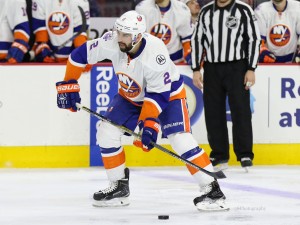At the end of January, we took a look at a few Islanders whose statistics seemed due for extreme regression. Often times in hockey, and all sports for that matter, exceptional numbers can be explained by unsustainable averages; it’s the rare player who drastically improves or declines in the blink of an eye. Over the course of a season, those averages tend to regress toward the mean, and a player’s accompanying statistics – goals, points, plus/minus, etc. – fall in line with past results.
A month ago, we supplemented our analysis of each player with a prediction for the rest of the season. Predictions are fun because they’re basically irresponsible guesswork, but in this case they felt more informed, and in turn, more reliable. So today, let’s check in on those predictions and see if we had any clue what we were talking about. (I think we did.)
Brock Nelson
Then (as of 1/31): Nelson had 19 goals through 47 games, putting him on pace for a 33-goal season. By all outward appearances, it seemed to be a breakout year for the former first-round pick – until you considered his shooting percentage.

The Numbers Said: At 17.28 percent in even-strength situations, Nelson was blowing his career average (11.4 percent) out of the water. We felt the former number was due to come back down to earth, and Nelson would end up approaching the 30-goal plateau but not quite reaching it.
Now: In the 13 games since, Nelson has just two goals. Not surprisingly, his even-strength shooting percentage in that span comes in at 10 percent, dragging him down to 15.8 percent for the season. With 21 goals through 60 games, Nelson is now on pace for 28 goals – still an impressive output, but not quite as glamorous as 30-plus.
Anders Lee
Then: After tallying 25 goals in 2014-15, Lee had just six goals through 47 games, a paltry 10-goal pace for the season. Fans were wondering what was wrong with the bruising goal-scorer, concerned he had taken a step back in his sophomore campaign.

The Numbers Said: If Nelson was at one end of the shooting percentage spectrum, Lee was at the other. With a mark of just 5.1 percent in all situations, he was clearly the victim of some poor luck. We predicted that number would start to climb toward his career average of 10.5 percent over the second half of the season, enabling Lee to make a late run at 20 goals.
Now: Lee has scored three goals in the 13 games since, driven by a shooting percentage of 11.1 percent in all situations. If he maintains that number through the rest of the season (give or take a percentage point) and continues to produce about 2.5 shots per game, he’ll end up with around 15 goals, a fine recovery after a hard-luck start.
John Tavares
Then: With just 34 points through 44 games, Tavares was scoring at the lowest rate of his career since his rookie season. After nearly winning the Art Ross trophy the year before (damn you, Jamie Benn!), his precipitous drop-off was puzzling.

The Numbers Said: Basically, Tavares was being let down by his teammates. While his goal output was on par with his career average, his assist total was well below it, mostly a product of those around him not finishing plays. The Isles’ shooting percentage with Tavares on the ice was just 7.0 percent at even strength, and 9.5 percent across the board. We figured both numbers were due to rise as his linemates started scoring more frequently, lifting Tavares’ overall production in the process.
Now: Tavares has caught fire since the start of February, tallying 16 points in 13 games – nine of them assists. The implication is that his linemates have stepped up their play, and sure enough, Tavares’ on-ice shooting percentage over the past month checks in at 8.9 percent at even strength, and 11.9 percent across the board. If this keeps up – and there’s no reason to think it won’t – Tavares should near 80 points on the season; last year, he had 86.
Nick Leddy
Then: A plus-20 player for his career, Leddy was a team-worst minus-11 through 47 games. That kind of deviation seemed unfathomable, especially considering Leddy looked like the Isles’ steadiest defenseman.

The Numbers Said: Where Tavares was being hobbled by his linemates, Leddy was being let down by the team’s goalies. With Leddy on the ice, Jaroslav Halak and Thomas Greiss had combined for a save percentage of .901, an ugly mark that really had nothing to do with Leddy himself. We suggested this would turn over the second half of the season, and Leddy’s plus/minus would more accurately reflect his level of play.
Now: Leddy is a plus-1 in the 13 games since, largely because Halak and Greiss haven’t been leaking goals like a BP oil tanker behind him. Their cumulative save percentage is .929 over this stretch, a number befitting a top defenseman like Leddy. The Minnesota native probably won’t finish anywhere near last year’s plus-18, but he’s certainly been vindicated over the past month.
The Lesson, as Always…
Trust the numbers. The numbers don’t lie. The numbers are our friend.
And when something unusual is happening, there’s almost always an unsustainable force behind it.